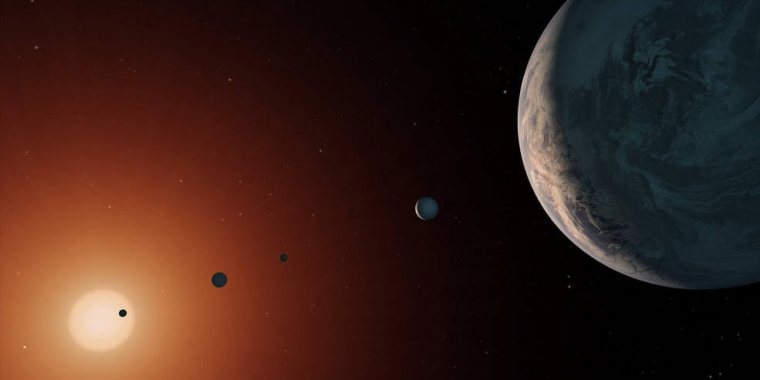| News / Science News |
TRAPPIST-1 is Older Than Our Solar System
Scientists now have a good estimate for the age of one of the most intriguing planetary systems discovered to date -- TRAPPIST-1, a system of seven Earth-size worlds orbiting an ultra-cool dwarf star about 40 light-years away. Researchers say in a new study that the TRAPPIST-1 star is quite old: between 5.4 and 9.8 billion years. This is up to twice as old as our own solar system, which formed some 4.5 billion years ago.

This illustration shows what the TRAPPIST-1 system might look like from a vantage point near planet TRAPPIST-1f (at right). ![]()
At the time of its discovery, scientists believed the TRAPPIST-1 system had to be at least 500 million years old, since it takes stars of TRAPPIST-1’s low mass (roughly 8 percent that of the Sun) roughly that long to contract to its minimum size, just a bit larger than the planet Jupiter.
However, even this lower age limit was uncertain; in theory, the star could be almost as old as the universe itself. Are the orbits of this compact system of planets stable? Might life have enough time to evolve on any of these worlds? It is unclear what this older age means for the planets' habitability.
On the one hand, older stars flare less than younger stars, and Burgasser and Mamajek confirmed that TRAPPIST-1 is relatively quiet compared to other ultra-cool dwarf stars.
On the other hand, since the planets are so close to the star, they have soaked up billions of years of high-energy radiation, which could have boiled off atmospheres and large amounts of water.
In fact, the equivalent of an Earth ocean may have evaporated from each TRAPPIST-1 planet except for the two most distant from the host star: planets g and h. In our own solar system, Mars is an example of a planet that likely had liquid water on its surface in the past, but lost most of its water and atmosphere to the Sun’s high-energy radiation over billions of years.
However, old age does not necessarily mean that a planet's atmosphere has been eroded. Given that the TRAPPIST-1 planets have lower densities than Earth, it is possible that large reservoirs of volatile molecules such as water could produce thick atmospheres that would shield the planetary surfaces from harmful radiation.
A thick atmosphere could also help redistribute heat to the dark sides of these tidally locked planets, increasing habitable real estate. But this could also backfire in a "runaway greenhouse" process, in which the atmosphere becomes so thick the planet surface overheats – as on Venus.
Fortunately, low-mass stars like TRAPPIST-1 have temperatures and brightnesses that remain relatively constant over trillions of years, punctuated by occasional magnetic flaring events. The lifetimes of tiny stars like TRAPPIST-1 are predicted to be much, much longer than the 13.7 billion-year age of the universe (the Sun, by comparison, has an expected lifetime of about 10 billion years). (NASA/JPL)
YOU MAY ALSO LIKE



